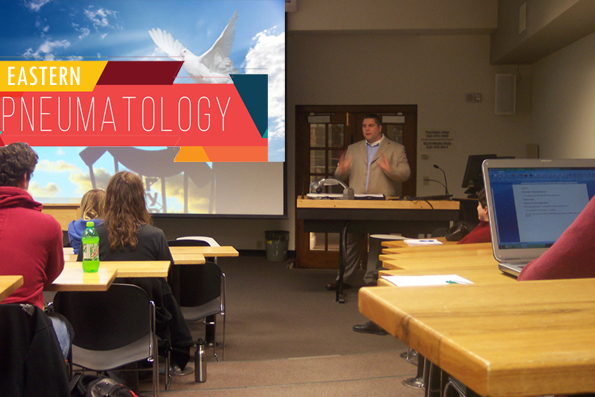The East Syrian (Assyrian) Church

Dony K. Donev, D.Min.: Eastern Pneumotology Lectures
Eastern Orthodoxy can be expressed in one word: theism. The purpose and meaning of life is to become more like God. Deification is pursued by all means of human existence. This quest for divine likeness often includes the typical for the Eastern Church, speculation on the divinity and humanity of Christ, traditions on the doctrine of the Trinity and non-traditional mystical experiences. They appear in the context of both physical and spiritual characteristics in individual and corporate ecclesiastical environment. The role of the Spirit in the process of deification is threefold and involves: creation, re-creation and theism. Eastern Pneumotology follows the graduate process of theism development. The Spirit is involved in the original creation of the world as well as the new-birth experience. His work however, does not end there, but continues throughout the process of personal deification of the believer.
The East Syrian (Assyrian) Church
The Assyrian Church is viewed in direct connection with the Jacobites.[1] The church grows in the context of Nestorianism and Assyrian practices.[2] Yet, the literature of the Assyrian Church is full of pneumatologay including symbolic language and profound spirituality.[3] For example, Narsai’s (413-ca. 503) pneumatology is strictly in the boundaries of liturgical and sacramental practices. An immediate contrast, however, is Isaac of Nineveh (7th c.), who, during sacraments, would suddenly fall on the floor, repeatingly rising up and kissing the cross.[4]
For Narsai the Spirit sanctifies and edifies the church through baptism.[5] In a similar manner, Hazzaya (d. ca 690), another Assyrian writer, views the Holy Spirit not only as Edifier, but also as Perfector of the Church.[6] As such, He brings transformation in the life of the believer.[7] This state is reached with beyond the conscious prayer.[8] It is accompanied with sweet odors,[9] tears of joy[10] and sound of glorification heard in the soul of the individual.[11] This description fits the previously discussed experience of Symeon the New Theologian.[12] Isaac of Nineveh also describes the ecstasy in the Spirit in the means of tears of joy[13] and “a state of drunkenness.”[14]
The above is strictly a personal experience.[15] In a corporate, ecclesiastical context, the union of individual experiences builds the Kingdom of God. In this sense the Kingdom is an already-not-yet reality, in which the direction of the Holy Spirit is essential. [16]
The gifts are essential for the life of the Kingdom. According to Narsai, the they are received through laying on of hands.[17] Healing is obtained through a similar ritual.[18] Isaac claims that they are bestowed in a time of prayer.[19] They are accepted in humility out of which comes as burning compassion for the creation.[20]
Hazzaya, furthermore, gives five practical signs for recognition of the works of the Holy Spirit: (1) love of God burns within the heart of the believer, (2) growth in humility of the soul, (3) kindness to all people, (4) true love and (5) vision of mind. His main tool to recognize demons and demonic visions from God and divine revelations is the peace of heart, which follows the heavenly presence.[21]
Peace can be also reached through reading of Scripture. According to Isaac of Nineveh, Scripture delivers us from every evil thought and turns our minds to good.[22] Scripture is to be read not by chapters, but a passage at a time with prayerful desire for understanding.[23] This is one of the first recorded attempts explaining the connection between pneumatic experiences and Scripture.
[1] Burgess, 85.
[2] Ibid., 88.
[3] Ibid., 89.
[4] A. J. Wensinck, Mystical treatises of Isaac of Nineveh, trans. From the Bedjan Syrian text (Amsterdam: Koninklijke akademie van wetenschappen, 1923), 95-96.
[5] R. Hugh Connolly, The Liturgical Homiletics of Narsai, Studies and Texts 8 (Cambridge: University Press, 1909), 46, 49-50.
[6] Alphonsi Mingana, “Joseph Hazzaya: The Shortest Path that Leads us to God,” Early Christian Mystics, Woodbroke Studies 7 (Cambridge: W. Heffer and Sons, 1934), 148.
[7] Ibid.,149.
[8] Ibid., 171.
[9] Ibid., 148-49.
[10] Ibid., 183.
[11] Ibid., 183.
[12] Disc. 3329.5, 313.
[13] Wensinck, 330.
[14] Ibid., 253.
[15] Mingana, 157.
[16] Ibid.
[17] Connolly, 8, 21, 34, 40, 49, 53, 63.
[18] Ibid., 35, 44.
[19] Wensinck, xxxix, 116-17.
[20] Ibid., 388.
[21] Mingana, 173-74.
[22] E. Kadloukovsky and G. E. H. Palmer, Early Father from the Philokalia (London: Faber and Faber, 1954), 242.
[23] Wensink, 84.







